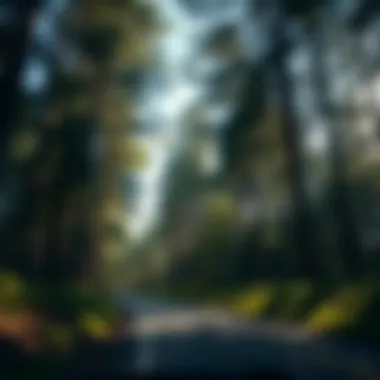Exploring the Beauty of Drive-Through Trees Worldwide


Intro
Drive-through trees encapsulate a unique intersection between nature and human interaction. These towering giants are not just passive remnants of the past; they stand as witnesses to centuries of ecological evolution, cultural narratives, and tourism that draws people from around the globe. Understanding these trees requires delving into diverse realms, including their geological formations, their role in ecosystem dynamics, and the delicate balance between conservation and tourism. As we embark on this journey to understand the magnificence of drive-through trees, it becomes essential to appreciate the forestry practices that contribute to their preservation and the broader implications these trees have on forest ecosystems.
Understanding Forestry Practices
In the context of drive-through trees, forestry practices play a vital role in ensuring their health and sustainability. These practices vary widely, influencing the very essence of how these natural wonders are maintained and appreciated by visitors.
Types of Forestry Practices
Forestry can be broadly categorized into several types, with specific practices applicable to drive-through trees:
- Selective Logging: This method involves carefully choosing which trees to fell, allowing the larger, iconic trees to remain intact while promoting the growth of younger trees.
- Agroforestry: Integrating agricultural crops with trees can enhance biodiversity and provide sustainable income for local communities without compromising the tree's ecological role.
- Reforestation: Planting trees in deforested or degraded areas aids in restoring ecosystems while creating a protective buffer for drive-through trees against environmental stresses.
Historical Context
The history behind drive-through trees is abundant and rich. Native communities initially recognized the significance of these trees, often attributing spiritual meanings or driving cultural practices linked to them. However, the commercialization began in the late 19th and early 20th centuries. As tourism swelled, eager travelers sought a unique experience, prompting some communities to carve out openings in these titans to accommodate vehicles. One prominent example includes the Chandelier Tree in California, which became a tourist attraction through sheer ingenuity and a bit of lumberjack spirit.
"Drive-through trees embody a unique bond between human curiosity and nature's grandeur, representing both a historical journey and a modern testament of adaptation."
Understanding these elements sheds light on the significance of proper forestry methods surrounding these trees. By respecting their historical context and employing sound forestry practices, we ensure that future generations can revel in their magnificence.
Preamble to Drive-Through Trees
Drive-through trees are not merely peculiar sights for curious travelers; they encapsulate the grandeur of nature and the intricate relationship between ecosystem and humanity. Their unique characteristics and historical significance make them a valuable topic for discussion, particularly in the context of conservation and land use. As we delve deeper into understanding these trees, we explore elements of biodiversity, tourism, and the cultural narratives woven around them. This exploration ultimately ends at the importance of preserving such natural wonders for future generations.
Definition and Characteristics
Drive-through trees are precisely as the name suggests; they are large trees that have been carved or shaped in such a way that vehicles can drive right through them. The most well-known examples are from the redwoods and sequoias of the United States. These magnificent trees typically exhibit the following features:
- Tall Stature: Many drive-through trees boast impressive heights, often exceeding 250 feet. This height contributes to their majestic appearance.
- Giant Trunks: The trunks are broad enough to accommodate vehicles. Some trees have openings made via natural decay or through intentional cutting to allow for passage.
- Diverse Species: While a majority of drive-through trees belong to the Sequoiadendron genus, other varieties can also be discovered elsewhere, depending on climatic conditions and geographical locations.
The physical grandeur of drive-through trees often draws visitors, sparking a sense of wonder and curiosity. Their unique characteristics become focal points in various cultural contexts, serving as symbols of resilience and life.
Historical Context
The first drive-through trees were carved during the late 19th and early 20th centuries, coinciding with the advent of automobile travel. This period marked a shift in how people interacted with nature. As roads modernized and the automobile became a staple, several trees were carved to attract tourists and capitalize on the growing road trip culture.
In the case of the Chandelier Tree in Leggett, California, it dates back to the early 1930s. This tree was specifically shaped to allow cars to pass—a move that epitomizes the era’s spirit of entrepreneurial creativity mixed with the desire to promote the natural world. Similarly, the deep-rooted cultural significance of such trees has persisted through generations, reflecting an ongoing fascination with nature’s wonders.
As we trace the history of these trees, it's evident that drive-through trees have transcended their geographical boundaries and now stand as cultural landmarks. They represent an intersection of human creativity and nature's immutable beauty, reminding us of the stories that bind us to the earth.
The Ecology of Drive-Through Trees
The unique spectacle of drive-through trees goes beyond just being a quirky tourist attraction; they play a vital role in the ecological landscape of their surroundings. These magnificent trees, primarily found in regions like California, stand tall as living monuments that provide a glimpse into the intricate web of life that they support. Understanding the ecology surrounding drive-through trees helps to underline their significance, not only in terms of aesthetics but also as fundamental components of their habitats.
Habitats and Biodiversity


Drive-through trees are often situated in dense forest ecosystems, which are rich in biodiversity. These habitats support a multitude of plant and animal species that rely on the trees for food, shelter, and breeding grounds. For instance, the towering redwoods attract various wildlife, including birds like the acorn woodpecker, which excavates cavities in the soft bark, and small mammals that thrive in the underbrush.
The presence of these trees contributes to the overall health of their ecosystems. They help maintain soil quality by preventing erosion and assisting in the water cycle. Additionally, the fallen leaves and decomposing wood offer nutrients back into the soil, sustaining the flora that thrives in their shade. The unique structure of these trees, often characterized by large openings or tunnels, creates microhabitats conducive to numerous species.
In essence, the biodiversity around drive-through trees is a sign of a healthy ecosystem where various life forms coexist, interacting in intricate ways. The more diverse an ecosystem, the more resilient it becomes to environmental changes, making these trees true guardians of ecological balance.
Interaction with Ecosystems
Drive-through trees do not exist in isolation; they are part of complex ecological interactions that define the health of an entire community of organisms. The relationship between drive-through trees and their environment is dynamic.
For example, the roots of these ancient giants extend deep into the soil, stabilizing it and preventing landslides—a crucial function in hilly terrains. Furthermore, their expansive canopy provides shade, moderating temperature for lower-lying plants while reducing evaporation during hot spells.
The trees also engage in a fascinating exchange of energies and nutrients through their complex root systems, partnering often with mycorrhizal fungi. This underground network allows for the sharing of resources among plants, thus promoting mutual growth and survival.
"Drive-through trees are not just remarkable physical structures; they are integral to ecological webs that sustain life for countless species, from the smallest microorganisms to larger mammals."
Additionally, drive-through trees can affect local weather patterns. Their sheer size can influence wind currents and rainfall distribution, showcasing how a single element in an ecosystem can have far-reaching impacts. Harvesting these resources sustainably is essential, as over-visiting or damaging these trees can disrupt these delicate interactions.
In summary, the ecology of drive-through trees is multifaceted and reflects a wealth of interactions that benefit the surrounding environment. Acknowledging these relationships not only enhances our appreciation for these natural wonders but also reinforces the importance of their conservation. Each tree tells a story of resilience, adaptation, and the need to protect our natural heritage.
Notable Drive-Through Trees Around the World
Drive-through trees capture people’s imaginations and serve as grand gateways into the mysteries of nature. They bring a unique element to the landscape, merging the human experience with the wild, and offering visitors a chance to connect with nature in a direct way. These remarkable trees often have historical significance, telling stories of the earth's beauty and resilience. From their origins to the ecosystems they support, understanding notable drive-through trees is crucial for appreciating their value and promoting conservation efforts.
California's Giant Sequoias
History and Growth
The history of California's Giant Sequoias speaks volumes about their enduring presence on our planet. These trees, among the oldest living organisms, can grow over 300 feet high. Their immense size and longevity can be traced all the way back to prehistoric times, where they stood tall long before the first humans set foot in North America. This historical aspect not only illustrates their role in the natural world but also emphasizes the necessity for their protection. These Sequoias thrive in specific conditions, and understanding their growth patterns provides insight into climate change and its impact on forests.
- Seasonal Weather Patterns: They flourish in places with wet winters and dry summers, showcasing nature's delicate balance.
- Fire Resistance: Their thick bark provides resistance to fire, explaining their survival over millennia. This unique adaptation can actually be beneficial, allowing them to contribute to the regeneration of their ecosystems after fire events.
Their captivating histories are a lure for many tourists, raising awareness about the trees’ ecological importance—awareness that is crucial for their future.
Significant Specimens
Within the realm of California's drive-through trees, notable specimens stand out. A prime example is the
Cultural Significance of Drive-Through Trees
Drive-through trees are more than just natural wonders; they embody a unique cultural significance that resonates deeply within societies around the world. These majestic giants draw people in, both physically and symbolically. They become roadside attractions and backdrops for personal memories, reflecting the intersection of nature, community, and tourism. Understanding their cultural importance allows us to appreciate not only the trees themselves but also the stories and meanings that people attribute to them.
Symbolic Interpretations
The drive-through tree is often seen as a symbol of perseverance and strength, standing tall against the test of time. Their ability to endure harsh weather conditions, human interference, and the passage of time resonates with many. People interpret these trees through various lenses:
- Cultural Icons: Many indigenous cultures view giant trees as sacred entities. They symbolize life, growth, and a connection to ancestors.
- Nature vs. Human Endeavors: The act of driving through the trunk highlights humanity's interaction with nature, showcasing both reverence and, at times, an invasive approach.
- Tourism and Adventure: For many, experiencing a drive-through tree signifies a spirit of adventure, a desire to connect with nature in a unique way.


Each interpretation not only deepens the human experience but also emphasizes a broader narrative about our relationship with the environment. These magnificent trees remind us that sometimes we must slow down and take a moment to appreciate nature’s artistry and resilience.
Influence on Art and Literature
Drive-through trees have sparked the imagination of countless artists, writers, and poets. They are not just natural wonders; they are muses that inspire creativity and expression. Their influence transcends cultural boundaries. Some specific examples include:
- Paintings and Photography: Artists have long captured the beauty of drive-through trees, framing them as majestic backdrops, symbols of wonder, or even subjects of environmental commentary.
- Literature and Poetry: In literary works, these trees often symbolize journeys, both physical and emotional. They stand as metaphors for the paths we take in life.
- Folklore and Myths: Numerous legends are associated with iconic trees, embedding them within the fabric of cultural narratives and regional identities.
The cultural significance of drive-through trees manifests not merely through their physical presence but also through their roles in artistic expression and storytelling. They serve as a bridge between the natural world and human creativity, enriching our understanding of nature’s influence on cultural development.
“Drive-through trees are like portals to a bygone era, evoking nostalgia and a sense of adventure in those who pass through.
Tourism and Drive-Through Trees
Tourism focused on drive-through trees serves as a double-edged sword; it's a boon for local economies yet comes with responsibilities that can’t be ignored. These towering natural wonders do more than just invite thrill-seekers to cross under their massive branches. They create a unique intersection where the allure of nature meets human engagement. Understanding the dynamics of this relationship can shed light on ways to harness tourism for conservation rather than exploitation.
Visitor Engagement Practices
Engagement with visitors at drive-through trees goes beyond simply allowing cars to pass through. It's essential to create a meaningful connection that respects the ecological and cultural significance of these trees. Here are some practices that have proven effective:
- Informative Signage: Placing informative plaques can help visitors understand the history and biology of the tree. This includes its age, species, and role in the ecosystem. When people know the backstory, their appreciation deepens, making their visit more than just an Instagram opportunity.
- Guided Tours: Organizing guided tours led by knowledgeable staff can enhance the experience. These tours can include discussions about the tree’s growth, its environmental significance, and local flora and fauna, fostering an educational angle.
- Interactive Workshops: Engaging visitors with hands-on experiences—like tree planting or conservation efforts—can create lasting impressions. This approach not only educates but also fosters a sense of responsibility towards preservation.
- Community Involvement: Getting local communities involved in tourism practices creates a sense of shared ownership. When residents have a stake in managing the site, their passion for protecting the trees can lead to more sustainable practices.
This variety in engagement helps ensure that visitors leave with a greater understanding and respect for these natural giants, promoting responsible tourism.
Environmental Impact of Tourism
The influx of tourists to drive-through trees brings with it both benefits and challenges. Carefully monitoring the environmental impact is crucial to ensuring the longevity of these natural landmarks. Some key points include:
- Habitat Disturbance: Increased foot and vehicle traffic can disturb local wildlife. It becomes critical to manage access routes and timing to minimize disruptions to habitats, especially during breeding seasons.
- Pollution: Cars emit fumes, which can negatively impact air quality. Efforts must be made to encourage eco-friendly practices, such as promoting electric vehicle access or providing shuttle services from nearby towns to reduce pollution.
- Litter and Waste: With higher visitor numbers, there's a risk of increased littering. Implementing stricter waste management systems, like recycling bins or composting stations, can mitigate this issue.
- Conservation Funding: Tourism can provide necessary funds for conservation projects. Entrance fees or voluntary contributions can be channeled towards maintaining the area, helping to safeguard the trees for future generations.
In summary, while tourism opens doors to economic growth, vigilance is required to strike a balance between enjoying these magnificent trees and protecting their ecosystems.
"Drive-through trees stand as living monuments to resilience and history, but they also require care and respect from those who seek to marvel at their grandeur."
By fostering responsible tourism, we can ensure that these natural treasures are protected and appreciated not just today, but for many tomorrows ahead.
Conservation Efforts for Drive-Through Trees
The preservation of drive-through trees is of paramount importance not only for their ecological significance but also for their cultural legacy. These trees, which have captured the imagination of many, are living testaments to the enduring beauty and complexity of nature. As such, effective conservation efforts are crucial to ensure that future generations can appreciate their grandeur. Conservation strategies facilitate a blend of ecological stewardship and community involvement, making them an essential focus of this article.
Challenges Facing Drive-Through Trees
Drive-through trees encounter various threats that jeopardize their existence. Some of these challenges are:
- Urban Development: Rapid expansion of urban areas often leads to habitat destruction. Drive-through trees can be caught in the crossfire of new constructions or highways, diminishing their necessary ecosystem.
- Climate Change: Fluctuating weather patterns can alter the habitat conditions necessary for these trees to thrive. An increase in temperature, changes in precipitation patterns, and more extreme weather events contribute to their declining health.
- Tourism Pressure: While tourism can bring awareness to the need for conservation, it can also be a double-edged sword. Increased foot and vehicle traffic can lead to soil compaction and damage to delicate root systems, which diminishes their growth potential.
- Pests and Diseases: Invasive species or a sudden influx of diseases can wreak havoc on native trees, weakening their structures or leading to mortality.
Keeping these challenges in mind, it is evident that dedicated resources and adaptive strategies are vital for the conservation of these majestic trees.


Successful Conservation Strategies
Despite these challenges, numerous successful conservation strategies have been implemented with positive outcomes. Some examples include:
- Protected Areas: Establishing parks and reserves dedicated to drive-through trees creates safe havens from urban encroachment and allows for a controlled tourism experience. For instance, areas like the Redwood National Park have seen positive results in ecosystem health through stringent regulations on visitor access.
- Community Engagement: Initiatives that involve local communities promote awareness and active participation in conservation efforts. Educational programs and volunteer opportunities can bolster local pride and commitment to preserving drive-through trees.
- Research Initiatives: Ongoing research into the health and longevity of drive-through trees aids in understanding pest resistance and disease management. Universities and research organizations often partner with conservation groups, maximizing data collection and increasing the chances for successful strategies.
- Sustainable Tourism Practices: Encouraging tour operators and visitors to engage in eco-friendly practices helps minimize environmental impact. This may include promoting guided tours, limiting vehicle access to certain areas, or providing educational content about sustainable interaction with nature.
Together, these strategies not only combat existing threats but also foster a symbiotic relationship between these natural wonders and their admirers.
As conservationists fine-tune these approaches, drive-through trees may emerge not only as surviving specters of ancient ecosystems but also as thriving, integral components of a balanced natural landscape. Being proactive in their preservation is not just a responsibility but a commitment to safeguarding our environmental heritage.
The Future of Drive-Through Trees
The future of drive-through trees holds significant importance not just for their survival, but also for the broader ecological landscapes they occupy. As urbanization encroaches rapidly upon natural habitats, we face an urgent need to safeguard these stunning giants. Beyond their aesthetic appeal, drive-through trees embody a complex ecological narrative that intertwines history, culture, and environment. Protecting these arboreal wonders ensures the preservation of biodiversity, enhances tourism, and fosters a deeper appreciation for nature among future generations.
Potential Threats
Drive-through trees face various threats that can jeopardize their existence and, by extension, the ecosystems they support. Some of the most pressing threats include:
- Climate Change: Changes in temperature and precipitation patterns can stress these trees, making them susceptible to disease and pests.
- Pollution: Air and soil pollution can weaken trees, impairing their growth and leading to premature death.
- Invasive Species: Non-native species can outcompete local flora, further endangering the delicate balance of the habitats these trees are part of.
- Tourism Pressure: While tourism can generate funds for conservation, excessive foot traffic can lead to soil compaction, root damage, and littering, all of which harm the health of these trees.
Addressing these threats requires collaborative efforts from forestry professionals, local communities, and governmental bodies.
Innovative Sustainable Practices
In the face of these challenges, a range of innovative sustainable practices can be implemented to safeguard the future of drive-through trees. These practices encourage both conservation and responsible tourism, ensuring the health and longevity of these remarkable natural treasures. Some promising examples include:
- Eco-Tourism Initiatives: Developing low-impact tourism options fosters awareness among visitors about environmental conservation and the significance of drive-through trees.
- Community Engagement Programs: Involving local communities in conservation efforts can empower them to be stewards of the environment. Workshops, volunteer days, and educational outreach can help build this connection.
- Monitoring Systems: Utilizing technology, such as drones and satellite imaging, provides precise data on tree health and ecosystem changes, enabling proactive management.
- Sustainable Forestry Practices: Implementing practices such as selective logging and controlled burns can maintain the health of the surrounding ecosystem while avoiding damage to these iconic trees.
"It is our responsibility to understand and mitigate the impacts of human activity on our forests, ensuring that future generations can marvel at our natural heritage."
In summary, the future of drive-through trees depends on our ability to recognize the value of these trees and respond proactively to potential threats. By promoting innovative practices and involving various stakeholders, we can work towards a future where these magnificent wonders continue to thrive.
Final Thoughts
As we wrap our exploration of drive-through trees, it's essential to emphasize the profound role they play not just in the physical landscape but also in cultural and ecological narratives. These magnificent giants are more than just a tourist attraction; they are living testimonies of resilience and ecological diversity. Their ability to thrive over decades, even centuries, is a reflection of a dynamic ecosystem that requires conscious efforts for its preservation.
The Importance of Preservation
Preservation of drive-through trees is imperative for several reasons. First and foremost, these trees are integral parts of local ecosystems, providing habitats for numerous species and promoting biodiversity. When we lose trees like these, we lose much more than just aesthetics; we lose interlinked relationships that have developed over many years.
Additionally, drive-through trees often serve as educational resources. They offer a tangible connection to nature, allowing individuals to grasp the magnitude of ecological time and processes. Educating visitors about the biological and historical significance of these trees fosters a sense of stewardship within communities. This sense of duty can lead to increased support for conservation efforts.
Moreover, drive-through trees can be victims of natural and human-induced threats. Climate change, urban development, and disease outbreaks could endanger their existence. Hence, sustainable practices are paramount to ensure these trees remain standing for future generations. By preserving these natural wonders, we maintain not just the trees themselves but also the stories they recount about our planet's history.
Call to Action for Readers
This article aims to inspire readers to take active roles in the conservation of drive-through trees. Here are some ways you can contribute:
- Visit Responsibly: When you visit drive-through trees, ensure your presence doesn't harm their surroundings. Follow guidelines and respect the natural habitat.
- Support Local Conservation Efforts: Get involved with or donate to organizations that fund conservation initiatives. Your support can make a significant difference.
- Educate Others: Spread the word about the importance of these trees. Share your knowledge with friends, family, or through social media platforms.
- Advocate for Policy Change: Engage in discussions about policies that protect natural habitats. If you have the chance, speak up during public forums or contact your local representatives.
By taking these steps, we can all play a part in sustaining the legacy of drive-through trees. Let's not treat them as mere structures to drive through, but as remarkable elements of our cultural and natural heritage, deserving protection and respect.
"To preserve the trees is to preserve the past, the present, and the future."
Ultimately, the future of drive-through trees hinges on our actions today. As stewards of the environment, we hold the responsibility to ensure their grandeur continues to inspire and educate generations to come.







